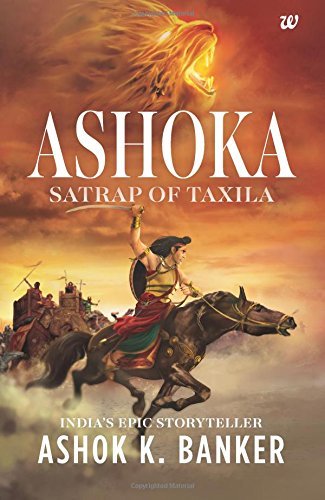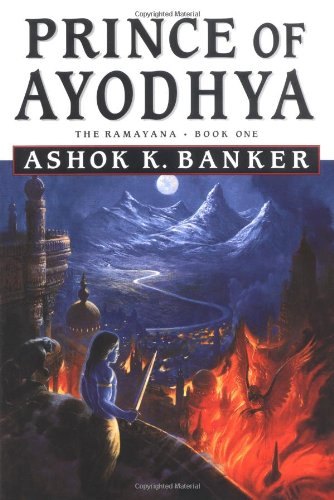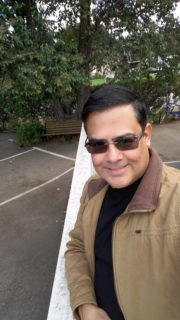 Ashoka: Satrap of Taxila by Ashok K. Banker (Westland Publications, 2017). The K. stands for Kumar. I don’t know if Ashok K. Banker goes to the White Castle. I had read somewhere that Ashok Banker said that he liked Robert E. Howard. I remember seeing the Ramayana books published by Aspect/Warner in 2004. I thought I would give him a try. Ashoka is historical fiction, not fantasy. He admits this is a fictionalized account of the life of the Indian emperor, Ashoka the Great. The Mauryan Empire (320- 180 B.C.) was the biggest in India until the British took over the subcontinent. I find Indian history of interest. The north had periodic invasions of Aryans, Sakas, Parthians, Kushans, Turks, and finally the Mughals under Babur. Northern India is tied with Central Asia periodically. The south is tropical with the spices for the cuisine and architecture influencing South East Asia and the East Indies.
Ashoka: Satrap of Taxila by Ashok K. Banker (Westland Publications, 2017). The K. stands for Kumar. I don’t know if Ashok K. Banker goes to the White Castle. I had read somewhere that Ashok Banker said that he liked Robert E. Howard. I remember seeing the Ramayana books published by Aspect/Warner in 2004. I thought I would give him a try. Ashoka is historical fiction, not fantasy. He admits this is a fictionalized account of the life of the Indian emperor, Ashoka the Great. The Mauryan Empire (320- 180 B.C.) was the biggest in India until the British took over the subcontinent. I find Indian history of interest. The north had periodic invasions of Aryans, Sakas, Parthians, Kushans, Turks, and finally the Mughals under Babur. Northern India is tied with Central Asia periodically. The south is tropical with the spices for the cuisine and architecture influencing South East Asia and the East Indies.
Banker plays a little free with history. His main villain is Seleucus Nicator (d. 281 B.C), one of Alexander the Great’s generals who became one of the “Successors.” Seleucus is conspiring to conquer India for the wealth so he can turn west and overwhelm the other Successors. Seleucus ceded territory to Chandragupta, Ashoka’s grandfather and founder of the Mauryan empire for a bunch of war elephants. Chandragupta had an army with Scythians, Parthians, and Greeks in addition to Indians. His territory extended to include what is now Afghanistan. Young Ashoka is sent to quell a revolt in Taxila which is now north-west Pakistan, Osama bin-Laden territory. There is a lot of harem intrigue with a Khorasani princess looking to eliminate Ashoka. Historical mistake: Khorasan did not exist as a name until the Sassanid Persians in the 3rd Century A.D. At this time, it would have been known as Hyrcania. That would have been a great name to use. There is not much action. I was disappointed in there was little description of the weapons used or the armor worn. Part of a chapter was given over to a very awkwardly written sex scene of a threesome of the Emperor Bindusara, the Khorasani princess, and her maid. Andrew Offutt, we need you now! The book ends with some Afghans taking Ashoka prisoner and breaking the bones in his body. The novel just ends. I realize this is the middle of a trilogy or part of a series, but books should be self-contained in narrative. What strikes me as odd is the book is almost marketed as a young adult novel while the contents are most decidedly not.

Banker is from Bombay and has some Irish and Portuguese in the mix. I am not quite sure on the target audience. The books are written English, which as a friend of mine pointed out is the lingua franca of the Subcontinent. The Ramayana was abandoned by Warner after two out of seven books in the series. He might be looking to break out in the U.S. with perseverance. Houghton Mifflin Harcourt did publish his Upon a Burning Throne in hardback last year and paperback this year. Looking at the Amazon preview, The Burnt Empire appears to be a jump from adapting Indian history and mythology to his own world building. I will probably get around to reading more Ashok K. Banker in the future. His prose style is easy enough and the scenery is a change of pace.

The W at the top looks a lot like the Walgreens logo.
For the record, he did get to publish the rest of his Ramayana series and an omnibus version is available in ebook form from amazon. He also did a series based on the Mahabarahta, but the parts I read didn’t cover the more famous sections talking about Arjuna et al. The Mahabarahta adaptation is, IMO weaker than his Ramayana as he feels the need to whitewash certain aspects of what he’s talking about (I’m sorry Mr. Banker, the Varnas are in fact part of a caste system, and the term “republic” does not apply to a political system headed by someone called a “king”).